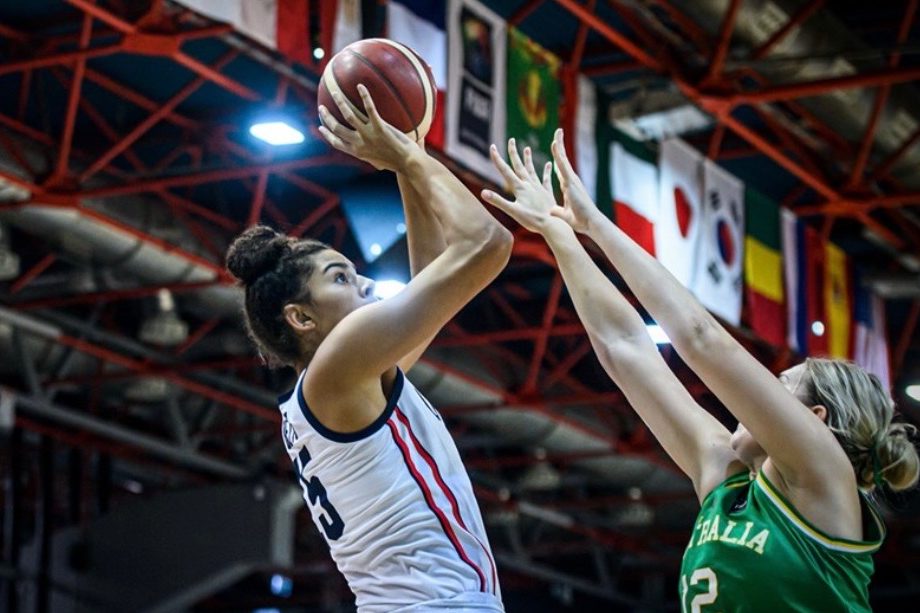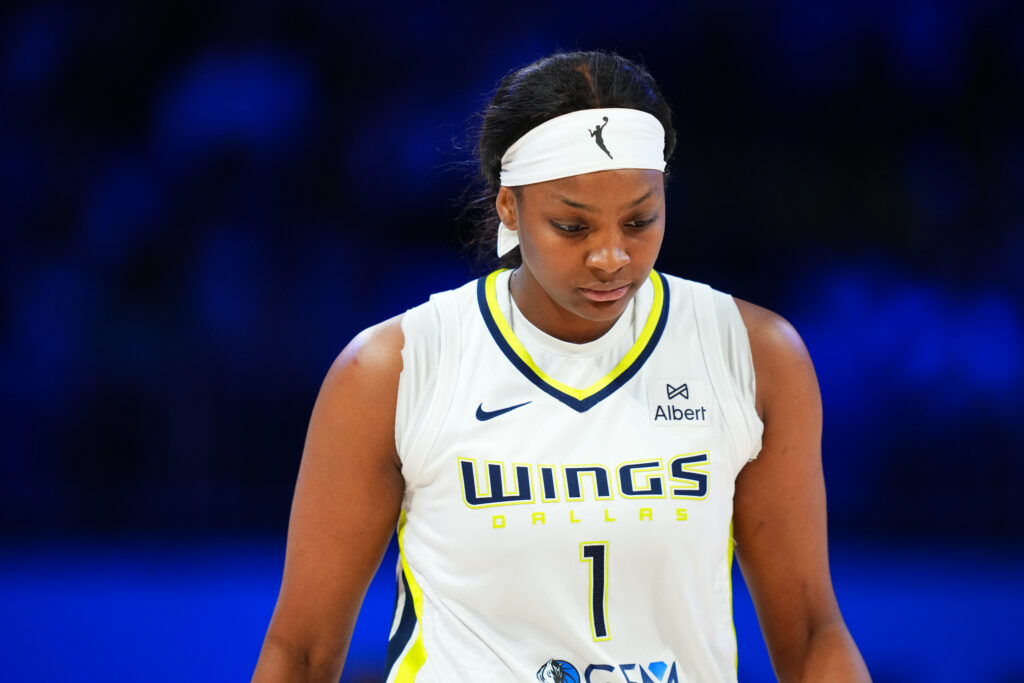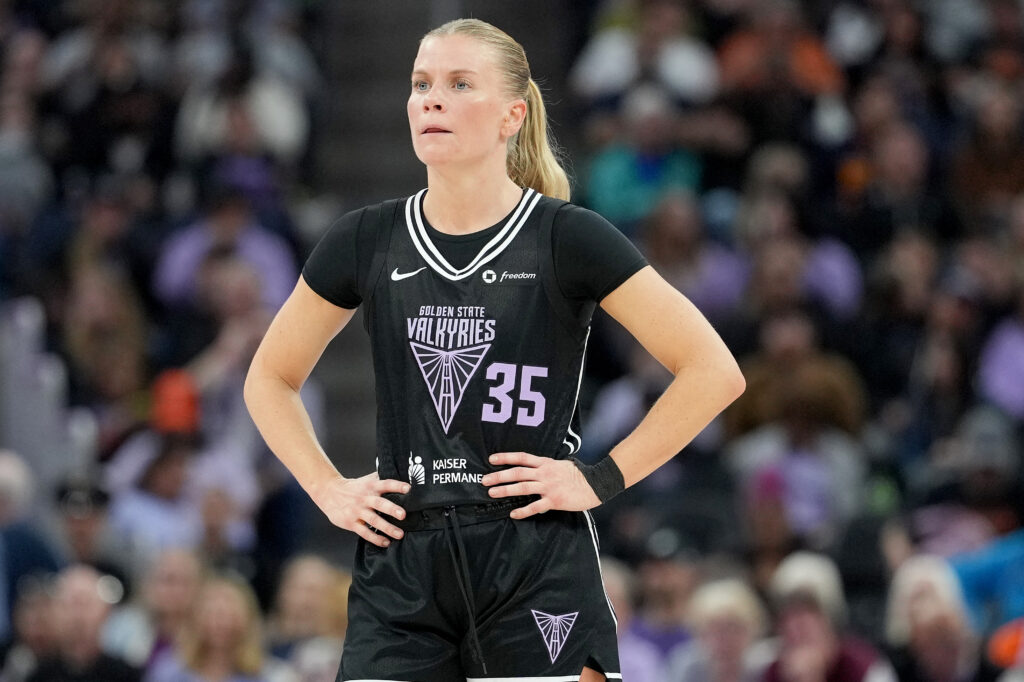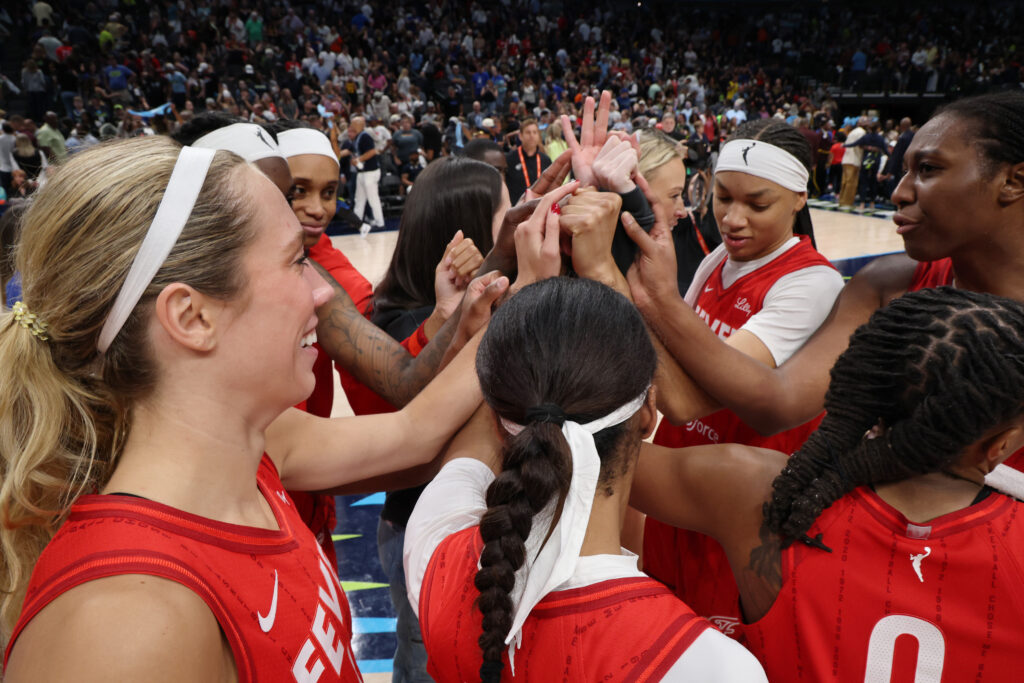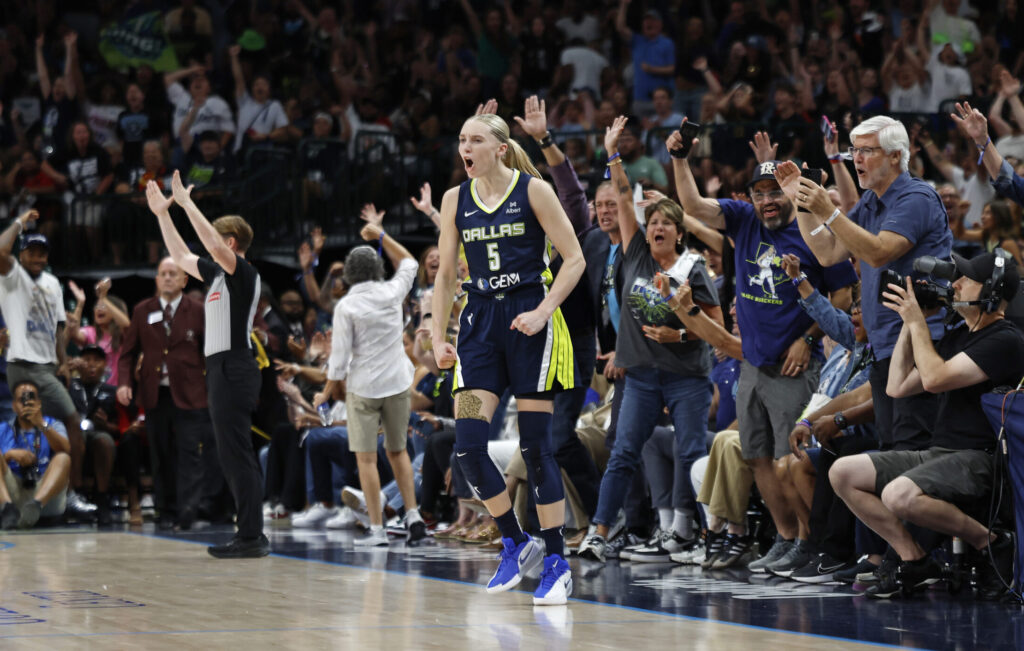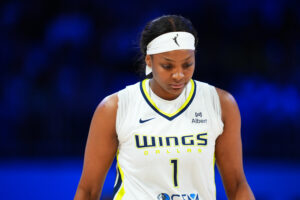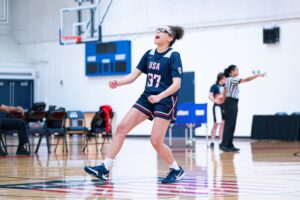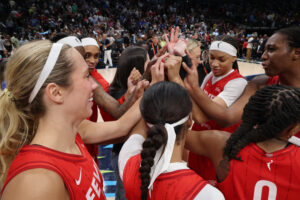From the time she was a little girl, Lauren Betts had a journal. Her mom, Michelle, remembers watching her scribble down her thoughts with a focused look. Pensive, Michelle says, has always been Lauren’s way.
Writing offered an outlet when Lauren needed to express herself and find the right words for how she was feeling. And there were a lot of feelings.
Lauren Betts is 6-foot-7. She has the kind of height people don’t normally see in a girl. So they had things to say, and those things weren’t usually kind. When you’re a boy, being tall is a gift. When you’re a girl, it often others you. And when you’re a tall, young Black girl at a predominantly white school, you really stand out.
As much as she wanted to, Lauren couldn’t hide. So she wrote, and she played basketball. On the court, 6-7 isn’t the norm either, but Lauren’s height separates her in a different way. It makes her special.
Lauren is the No. 1 college basketball recruit for the Class of 2022, a Stanford commit, the 2021 Gatorade Colorado Player of the Year, a member of Team USA’s U19 squad, and on and on.
From the outside, it seems like Lauren Betts should be a pillar of confidence. But reaching those heights was neither easy nor straightforward. This 18-year-old who has accomplished so much still has a long way to go, but she’s getting there. She’s found herself as a basketball player, she’s finding herself as a person and, through it all, she’s starting to find her voice.
Now, she’s ready to use it.
***
Basketball was a part of Lauren’s life long before it became her life, shaping her childhood and even where she was born.
Lauren spent her first nine years in Spain, and at one point, she was even fluent in Spanish. Lauren has lost a lot of that now, but she remains fluent in another language, one that spans countries and cultures and put her dad on a trajectory to meet her mom. A language that’s not so much spoken but played: the language of basketball.
Lauren’s basketball journey started in England of all places, with her dad, years before she was born.
England isn’t a country known for its love of basketball, but if you’re 6-8 by the time you’re 14, the sport tends to find you. That’s what happened to Andrew Betts when he went to watch his local professional team play. He got noticed.
Basketball ended up taking him all over the world. It took him to the United States, to play at Long Beach State — where he met Lauren’s mom, Michelle — and back to Europe, where he spent most of his career playing professionally in Spain.
During games, Andrew would look up in the stands and see three little faces — Lauren and her siblings, Sienna and Dylan — smiling down at him.
The oldest of those faces was captivated by her dad and the game he played. Lauren always had a plan. It’s what she does: plots and thinks and makes mental and physical notes. Sometimes on paper, sometimes in her head. But back in Spain, her future basketball stardom wasn’t on anyone’s mind but her own.
As the kids got older, the constant carry-on bags, planes and days on the road started to become too much. Andrew was getting older, too, and his contracts were getting shorter. From 2007 through 2012, he played for a different team every year. Moving the kids that often wasn’t an option.
Michelle worried they — Lauren especially — needed more of a routine. She was making friends and developing a life in Spain, and taking her away from that didn’t seem fair. So, the family set up a home base in Malaga. Andrew traveled with his teams, and Michelle and the kids often stayed home.
On Saturdays, the four of them spent their mornings at a local restaurant. Michelle sipped cappuccinos, and the kids slurped chocolate milk out of elegant glasses.
Lauren remembers the cafe seeming fancy, but now as a teenager, she’s not sure if that memory is true or if it was the projection of a little girl, romanticizing their weekend hangouts.
“It actually was pretty fancy,” Michelle says. “She was right about that.”
Lauren noticed things, even then.
“I remember it always being super fun,” Lauren says of those days in Malaga. “We would hang out with friends and go to the beach, and my mom had a great routine for us. The only thing that wasn’t fun was not being able to see my dad all the time, but overall it was a good thing.”
Her dad’s career meant Lauren got to experience the world in a way most kids don’t. That experience, she says, was probably lost on her as a child, but now she recognizes how special it all was.
“There are always memories popping up on my parents’ Facebooks, so a lot of times I will look at those and reminisce,” she says.
Being the daughter of a professional basketball player also prepared Lauren for the life she leads now. Then, she watched her dad play and dreamed of the day she could do the same. Travel was normal to her, as was the carousel of new people. Teammates were family, and family was everything. She learned about the power of routine and the dedication it took for her dad to play at such a high level, and for the people around him, like Michelle, to help him achieve that.
Basketball shaped everything happening around Lauren. And eventually, when she picked up the game, it started to shape what was going on inside of her as well.

Andrew has a photo on his phone of Lauren in her first year playing basketball. In it, she’s posing with her basketball coach, already taller than him. It’s a cute photo, and a little bit funny. There’s Lauren, around 10 years old with a little girl’s face, standing an inch or two above her grown-up coach.
But behind the eyes of that baby-faced giant, an internal struggle was already brewing.
Basketball started as a dream for Lauren, thanks to hours in the gym watching her dad play, but when his career was over and the Betts family moved to Colorado to be close to Michelle’s parents, Lauren clung to the game as a way to fit in.
“I went into it obviously because my dad played, but I just moved here from Spain, so for me I was going into it just to make friends,” she says. “Once I actually started getting, like, good, it was more than that, but I think just making those relationships was the most important thing to me when I started playing basketball.”
Lauren tried other sports growing up: swimming, soccer and volleyball — the sport her mom played at Long Beach State. But ultimately, the hardwood was her calling.
“We could tell right away with those that this wasn’t going to be her sport,” Andrew says. “But with basketball, when she started to get a feel for the game, you could just tell.”
Lauren, of course, remembers it differently.
“I was not good at all,” she says of her first days playing basketball.
Even with her natural skills, Lauren had to work. And she was willing from the start.
“I remember having a conversation with my dad where he said, ‘You are going to have to work really hard to get where you want to go.’ So from then on, I started working, going to the gym more, conditioning myself,” she says. “There was a lot of hard work that went into it. It didn’t come easy for sure.”
Lauren quickly developed skills and friendships on the court. But when she ventured outside of the gym, she spent middle school and the beginning of high school feeling like she didn’t belong anywhere.
As Lauren got older, she grew. And grew, and grew some more. People noticed, and Lauren noticed them noticing. Her perceptiveness is a strength, but in those moments, it would have been better if Lauren had been a little less aware.
“It was a serious struggle,” Michelle says. “And honestly, I think anyone would have struggled, because it’s not like she thinks that people are looking or she thinks they are talking about her. They actually are, and they are very blatant about it, too.”
It wasn’t just strangers staring on the street. Once Lauren hit sixth grade, the bullying started. There were looks and whispers when she went by, and nasty comments made right to her face. That’s the thing about middle school tormentors — they don’t feel the need to hide. As for Lauren, she couldn’t hide.
She wanted to bury everything, keep it to herself and her journal, but eventually her mom convinced her to see a counselor.
“I just thought that they weren’t going to help me, and they were going to think I was joking or not taking myself seriously,” Lauren says. “But I went to the counselor for the first time in middle school when my mom realized how bad my mental state was. I would go to her twice a week, and it helped me so much because I realized that I had someone to talk to that could help me and give me all these different ways to feel better about myself. Those things have taken me so far, and I definitely wouldn’t be where I am today if it wasn’t for reaching out to people.”
Michelle and Andrew have always been in Lauren’s corner. Throughout her mental health battle, they reminded her that, though her height made her different, that difference was beautiful.
They were right.
Middle school bullies weren’t the only ones noticing Lauren. Other people were talking about her, too, and they had nothing but good things to say.
The first time Lauren realized that she wasn’t just a good basketball player, but a great one, was when she was selected to play for Blue Star 30. The organization selects the 30 best players from the U13 and U14 age groups to partake in what it calls an “elite, invite-only event.”
And Lauren was one of them.
“That was the first time that I felt confidence in myself that I could keep up with the best basketball players in the nation,” she says. “Because there were a lot of good players my age from all over the country, and I was playing just as well as they were. I felt like I could actually do this. And if I kept working, I could become better than them.”
Suddenly, what Andrew and Michelle had long been trying to tell Lauren started to ring true in her own mind: The more success she had on the basketball court, the less the opinions of small-minded people off the court mattered.
She was a basketball player. Not a good one, not a great one, but a special one. And people all over the country knew it.
One event didn’t cure the turmoil happening in Lauren’s mind, but it started her on the right path.
“Once I started getting noticed by people outside of Colorado, I think that really boosted my confidence that I’m bigger than just a tall girl,” she says. “There is a lot more to me, and my height gave me advantages. I knew that if I kept going, I could keep succeeding in basketball. My height ended up being not a flaw, but a super huge part of who I am today.”

Who she is today is one of the best high school basketball players in the country. After the 2020-21 season, Lauren was named both the MaxPreps Colorado Player of the Year and the Gatorade Colorado Player of the Year.
She spent this past summer as the youngest player on the U19 USA basketball team. Many of her teammates had just finished their freshman years of college, like Iowa star Caitlin Clark, but Lauren played a key role in the squad’s gold medal run at the FIBA World Cup. Over seven games, she averaged 11.1 points, 9.6 rebounds and 1.9 blocks per contest.
The college basketball world has long known about Lauren — she was committed to Stanford before she played on the U19 team — but to have the success she had at 17 years old proved just how talented she is.
Of course, the first thing anyone sees is Lauren’s 6-7 frame. Being tall doesn’t equal talent. But Lauren has both. She’s not a tall person on a court; she’s a basketball player, through and through.
“She has always had great touch, and talking with college coaches, post players tend to develop later as far as footwork and coordination, but I felt like she had that as a freshman,” says Josh Ulitzky, Lauren’s high school coach.
She moves around the hoop with grace. She has the footwork to finish at the rim with a soft touch and hands that can catch even the most wayward of passes. Her calm, introspective demeanor makes its way onto the court, too. There’s poise and maturity in her decision-making and the way she doesn’t let the highs and lows of competition affect her.
“Nothing brings her down, and she fits in on whatever team she is on,” Andrew says. “She does whatever they need, whatever the coaches ask.”
Books could be written on her skills as a player, because she has that many. Lauren belongs on a basketball court.
More specifically, Lauren belongs on a basketball court in California, wearing Cardinal red.
It’s plastered all over her Twitter account. Her header is a photo of the family, with Lauren in the middle decked out in Stanford gear.
Then, there’s a pinned tweet accompanied by a posed photo of Lauren, her hair in a messy, off-kilter ponytail, pushing up glasses — her own, not a prop — with tape over the middle.
It’s a picture that lots of Stanford commits like to replicate, and Lauren had to jump in on the trend.
COMMITTED! GO CARDINAL! ❤️🌲 pic.twitter.com/Ly2YF8JkSS
— lauren betts (@laurenbetts12) January 13, 2021
“I didn’t think it would turn out at first,” she says, “but when the photographer showed me I was like, ‘Wow this is actually so cute.’”
It’s also a nod to her intellectual side.
“I would say I’m a little bit of a nerd,” she says. “I’m not a whiz, you know, like Fran Belibi (a fellow Coloradan and Lauren’s future teammate), but I did get into Stanford for a reason.”
Every school you can think of wanted Lauren (she is the country’s No. 1 recruit, after all). But choosing Stanford came easily, even if she didn’t get to visit the school until 10 months after committing due to the ongoing COVID-19 pandemic.
Over the phone, Lauren got to know her future coaches and decided it was the perfect fit.
“Just watching the team, I could tell that they’re just a very close team and that was important to me,” she says. “I want to have a great relationship with the other girls.”
Plus, it’s a quick flight from Colorado to California, so her parents can visit and watch her games. Lauren says a lot of people don’t even realize her parents have split up, calling them “the best divorced couple ever.”
“We never got along this well when we were married,” Michelle says with a laugh. “We are a way closer unit now.”
It’s a simple thing, but their amicable relationship is crucial for Lauren. Ever the thinker, she knows it could have been different. Most divorced people, she says, don’t act like her parents do.
“It’s nice to see that,” Lauren says of her parents’ relationship. “It helps me feel grounded and stable.”
Throughout her life, Lauren has had two constants: family and basketball. And soon, the latter will pull her away from the former. Nowadays, her few moments of free time are set aside for family and friends. To Lauren, what they do together isn’t nearly as important as the fact that they are together.
Lauren splits time between two houses. At her dad’s, she’s often in the driveway playing two-on-two basketball: Lauren and Sienna against Andrew and Dylan. She has a half-brother, Ashton, but at 5 years old, he’s a bit too young to partake in the matchups.
With her mom, Lauren just likes to talk. Michelle, she says, is the kind of person you get wrapped up with for hours, taking in the advice, discussions and anecdotes, and not realizing how much time has gone by.
“My mom is one of the most amazing people to talk to,” Lauren says. “When you’re having a hard day, I can just sit and have a two-, three-hour talk with her. It is one of my favorite things.”
Quality time is a priority for Lauren, maybe because the quantity is so minute.
Some nights, she likes to grab Sienna and the car keys. The two will just drive, listening to music, singing along and stopping every so often to take photos of each other and their surroundings — “We both love photography,” Sienna says. They usually turn up the radio and go with the flow of whatever is on: rap, pop and, occasionally, country.
“I’m going to expose her,” Sienna says with a laugh. “She loves rap and everything, but she really likes her country music.”
And according to her mom, Lauren is a good singer, too.
“She won’t tell anyone that, though,” Michelle says.
Her singing voice is reserved for the driver’s seat of her car, but as Lauren continues to come out of her shell, another voice is becoming loud enough for everyone to hear.

With Lauren’s basketball skills come responsibilities. Star players are expected to be leaders, and while Lauren has never had trouble leading by example, using her voice is a work in progress.
“That’s never something that I wanted to do growing up, because I was always a shy kid,” she says. “I’ve learned a lot about taking control a little bit, and using my voice in a way that is going to help my teammates win.”
Lauren’s journal is still a big part of who she is. In fact, she uses it more than ever these days. She loves to write — “When I start writing I kind of can’t stop myself,” she says — and organize her innermost thoughts. In a way, journaling is another kind of therapy, one that she dictates herself.
Recently, those thoughts have been centered on things going on in the world around her. Lauren has a plethora of entries about the Black Lives Matter movement, an issue very near to her heart.
Lauren attends Grandview High School. Sixty percent of the school’s student population is white, 17 percent Hispanic, 12 percent Asian and 8 percent Black.
“When I first started writing about [Black Lives Matter], I was in a very hard place. I go to a very non-diverse school, and I would walk around and hear opinions from people that were not very positive. So for me, writing it down gave me a safe place to say my opinions without people judging me,” she says.
Lauren, who turned 18 in October, has grown up with athletes who aren’t afraid to speak up about mental health, social justice and other causes they care about. Recently, Lauren was inspired by Simone Biles pulling herself out of the Olympics. In team sports especially, it can be hard for young athletes to prioritize themselves. That’s something Lauren is working on, and she wants others to do the same.
Athletes like Biles have a huge platform. Lauren isn’t at that level yet, but she knows there are kids, specifically little girls, who look up to her. And that’s only going to be amplified when she gets to Stanford next year.
Last year, Lauren met a middle schooler who was tall for her age. Without her having to say much, Lauren understood what the girl was going through at school.
“I let her know that everything was gonna be OK, and she started tearing up,” Lauren says about the moment. “It just made me think that I can really do this and I can really help people.”
Ulitsky has been a part of Lauren’s high school career from the beginning. In addition to being a coach and a teacher, he’s also a school counselor, so he’s seen Lauren’s journey firsthand.
When someone at school recently asked him if Lauren had gotten even taller, he was struck by just how far she’s come.
“No,” he replied, “She’s just standing up straight.”
Lauren no longer feels the need to shrink herself down so she can go unnoticed. She’s proud, and ready to be seen.
“That’s the part that is really cool to see, is her embracing that,” Ulitsky says.

The journal Michelle sees Lauren furiously writing in isn’t going away. She will always need an outlet to express herself. But now, Lauren knows her voice isn’t something to simply lock away in a notebook. It’s a tool, and one other people need to hear.
Lauren is considering studying psychology at Stanford so she can continue assisting people as they navigate tough times and mental health challenges. Whatever she ends up doing, Lauren knows she wants to help people — especially young, tall girls.
She doesn’t have to look far for that. In her own house, Sienna, a high school freshman, is already hovering around 6-foot-4.
She and Lauren are different, though. While Lauren’s self-confidence came late, she’s never seen her little sister struggle with it.
“Sienna is the most confident person I’ve ever met,” Lauren says. “Which is nice having her at school, because we walk around together and I just feel like two boss women.”
The younger Betts sister may not need help in that aspect of her life, but she still sees Lauren as someone she wants to emulate.
“I’ve always dreamed of being like her,” Sienna says. “Not necessarily being No. 1 or anything like that, but being someone. When she walks into a gym, everyone knows her and they are like, ‘Oh, that’s Lauren Betts!’ I think that’s amazing.”
Yes, she’s tall. Yes, she stands out. Yes, she’s different.
Yes, she’s amazing.
And finally, after years of self-doubt, Lauren Betts knows that, too.
Eden Laase is a contributing writer at Just Women’s Sports. She previously ran her own high school sports website in Michigan after covering college hockey and interning at Sports Illustrated. Follow her on Twitter @eden_laase.
